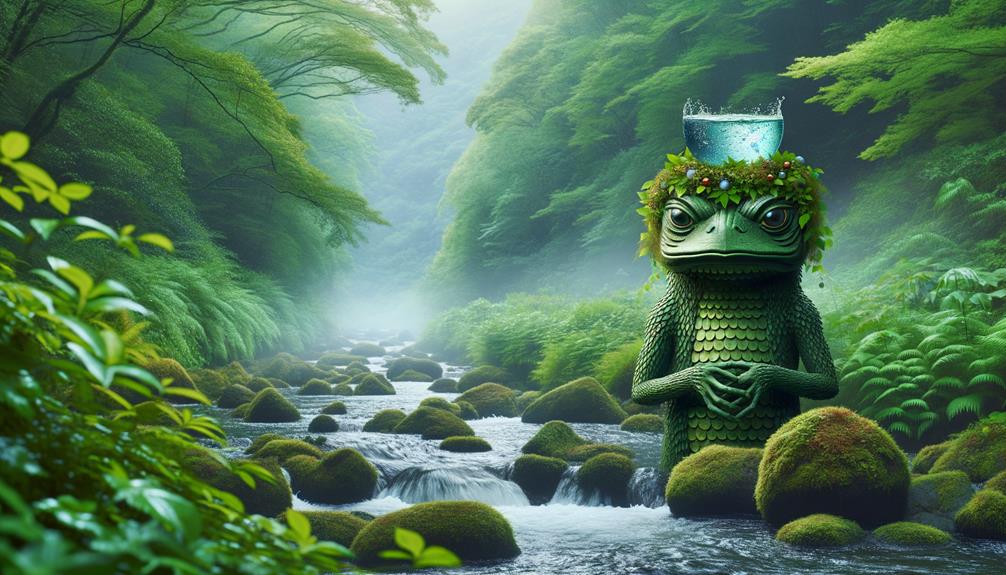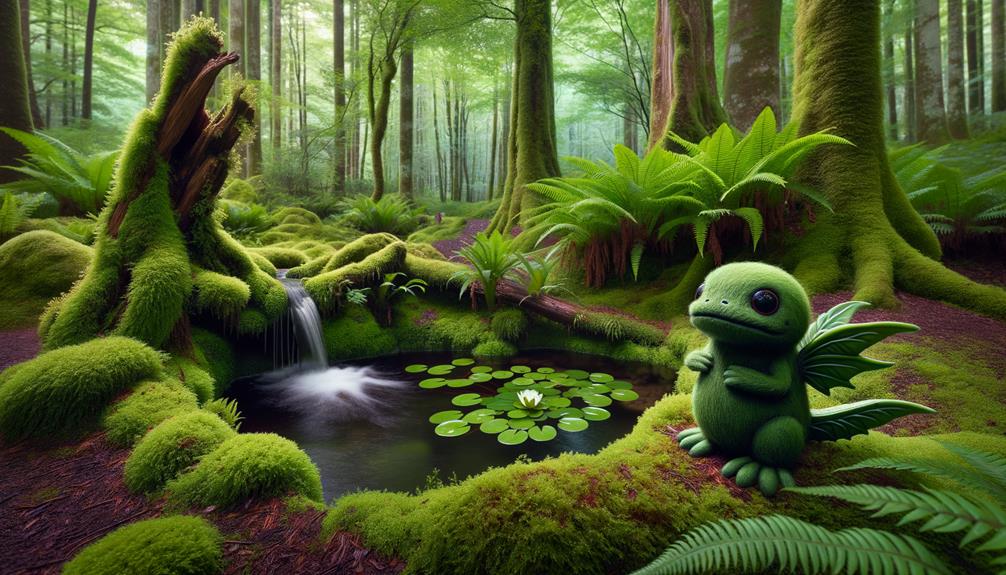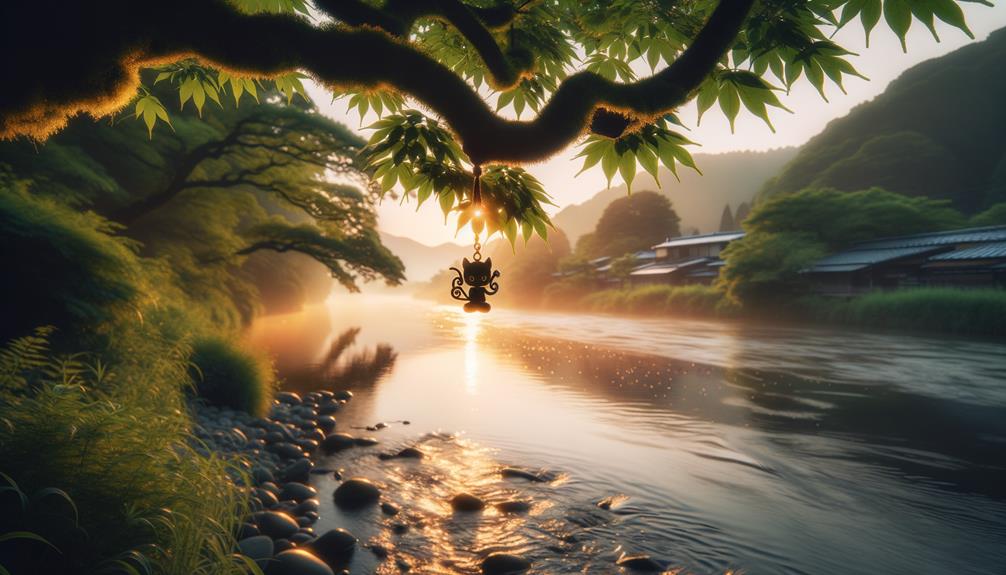Kappa, the mischievous water sprites from Japanese folklore, captivate with their complex nature – playful yet dangerous. Their green, scaly skin and bowl-like heads filled with water symbolize their aquatic roots and the fragile boundary separating life and irreverence. These tricksters remind us of the thin line dividing the sacred from the profane. However, their webbed hands and cunning grins intrigue, intertwining them seamlessly into ancient tales and contemporary culture. These elusive creatures undoubtedly harbor untold secrets awaiting discovery.
Origins and Mythology
Kappa, mystical water imps, occupy a unique space in Japanese folklore, their origins intertwined with ancient deities and mischievous spirits. The term itself, 'kawaappa,' conjures imagery of playful yet cunning beings, reflecting humanity's complex relationship with water – a life-giving yet treacherous element.
These creatures embody archetypal themes of duality, their benevolent and malevolent natures serving as reminders of nature's unpredictable power. Their connection to deities underscores a reverence for the natural world's capriciousness. Kappa invoke fear and respect, teaching lessons about the thin line between sacred and profane.
In Japanese culture, kappa blur boundaries between humans and the supernatural, acting as guardians and tricksters. Their origins underscore a narrative where the natural and spiritual worlds intertwine, urging recognition of the inherent duality within nature and ourselves.
Physical Characteristics

These eerie beings called kappas flaunt a fusion of the familiar and strange in their physical traits. Their greenish, scaly skin shimmers like amphibians, hinting they dwell in both water and land realms. This skin bridges those two worlds, the terrestrial and aquatic. Webbed hands and feet accentuate their liminal nature, allowing seamless movement across environments.
Atop their heads sits a saucer-like cavity, a reservoir holding water vital to their power and strength. This symbolizes their profound connection to the life-giving element. Their beak-like mouths evoke images of primordial creatures from ancient times.
The scaly skin represents their adaptability across realms. The saucer cavity shows their dependence on water for vitality. The webbed limbs highlight their mastery over aquatic and terrestrial domains. Collectively, these traits depict beings intimately tied to both the mystical and our tangible world.
Habitat and Lifestyle

Kappas, mischievous water spirits, dwell in serene freshwater sources like rivers and ponds. Their webbed hands and feet allow them to glide gracefully through these aquatic realms. Beyond their physical ties to water, kappas symbolize life's profound mysteries existing alongside the familiar.
These beings develop sacred bonds with turtles and cucumbers, riding them while embodying nature's cyclical rhythms. Their playful antics, especially with children, invite us into their whimsical world of water and chaos. Yet, these tricks aren't mere pranks – they underscore the delicate balance between reverence and irreverence.
Kappas' fluid movements mirror life's unpredictable ebbs and flows. Through mythology, they interweave the tangible and ethereal, remaining cherished figures in Japanese folklore's rich tapestry.
Famous Kappa Stories

Among kappa folklore, these stories highlight their cunning, trickery, and intertwined relationship with humans. One well-known tale involves a kappa seeking medical aid from a doctor after an injury, depicting the delicate balance between the supernatural and human skills as rivers and lakes seem interwoven with daily life.
Another narrative recounts a clever priest outsmarting a kappa by tricking it into bowing deeply until its life-sustaining water spills out, showcasing the vulnerability of kappas despite their power. It's a classic story of wit prevailing over brawn.
The legend of the Kappa and the Sushi Chef tells of a kappa teaching a chef the art of cucumber sushi rolls in exchange for sparing its life, underscoring mutual respect and knowledge sharing across realms.
These folktales explore three central themes surrounding kappas:
- Trickery and quick-wittedness
- Human ingenuity overcoming supernatural abilities
- Cross-cultural exchange of wisdom
Each story invites contemplation of humanity's multifaceted bonds with mystical river and lake dwellers woven into the social fabric.
Protecting Yourself From Kappas

Understanding kappa mythology means knowing their quirks. Offering cucumbers or refilling their water dishes can turn them from pests to allies. Making them bow reveals their vulnerability – humility triumphs in mythological encounters.
Identify Kappa Threats
Safeguarding against kappa's treachery requires understanding their sinister methods and the dangers they pose near water sources. These malicious tricksters are infamous for dragging unsuspecting victims, especially children, underwater, resulting in tragic drownings. But their cruelty extends further – they're believed to extract the shirikodama, a mystical entity said to contain one's soul, leading to death.
Keeping our children away from rivers and ponds where kappas lurk is crucial. Their mischievous nature amplifies the risk in these settings. Be wary of:
- Drowning Tactics: Kappas lie in wait near water to pull their victims under, symbolizing unseen perils in life's depths.
- Soul Extraction: By taking the shirikodama, kappas metaphorically steal an individual's essence, reminding us of our spirit's fragility.
- Deceptive Playfulness: Their playful guise masks sinister intent, teaching us to scrutinize appearances for hidden threats.
Recognizing these elements enables vigilance and protection for ourselves and loved ones.
Effective Defensive Techniques
Steering clear of water imps like kappas requires vigilance and protective measures. Venturing too close to rivers or ponds puts you at risk of their strong grip intent on dragging you into the depths. But there are tried-and-true defenses.
Eat cucumbers before entering the water – these vegetables have purifying properties kappas avoid. If confronted on land, bow deeply to make the water spill from the dish atop their heads, sapping their strength. Refilling this dish earns their gratitude, transforming foe into ally. In old Edo Tokyo, sending cucumbers downstream kept these spirits at bay as protective offerings.
Each tactic rooted in folklore helps navigate regions where kappas lurk. Staying informed about such mythological beings and their perceived weaknesses provides a layer of security against potential encounters. While rare today, maintaining traditions offers cultural wisdom for peaceful coexistence with nature's obscurities.
Kappa in Modern Culture

Kappa water sprites continue swimming through Japan's cultural currents. Their playful presence remains through cucumber sushi rolls and riverside warning signs. These aquatic tricksters' mischievous aura, tied to the element of water, still ripples through the national consciousness. Familiar kappa imagery reminds people of respecting yet exercising caution around nature's unpredictability.
Kappas manifest across Japanese society, like in cuisine. Their beloved cucumber has become a sushi roll staple, "kappa maki." It's a compact nod to these water imps intertwined with culinary tradition.
Near rivers and lakes, signage warns about kappas, blending mythology with real-world safety advisories. Kappa sushi rolls symbolize folklore merging with daily sustenance, making each bite honor these mythical beings. Through stories, visuals, and food customs, the kappa educates newer generations on Japan's rich mythological heritage.
The kappa, that watery symbol of playful mischief, remains woven into modern Japanese life, ancient lore intertwining with the contemporary fabric.
Frequently Asked Questions
What Happens if a Kappa Spills Its Water?
A Kappa's life force ebbs if its water reservoir spills. This humbling act creates a bond of gratitude between the yokai and whoever caused the mishap. The once formidable river imp grows vulnerable, its mystical powers diminished until the liquid is replenished. An intriguing cultural metaphor illustrating how even the mighty can be brought low by a simple, seemingly innocuous act.
Why Do Kappas Have Water in Their Head?
The water in a kappa's head represents life's mysteries and connects them to nature's primal rhythms, granting supernatural abilities. It glistens like a pool mirroring the cosmos – a profound essence embodying magic.
Is a Kappa a Demon or Imp?
A kappa symbolizes both playfulness and danger in Japanese folklore. Their mischievous antics teach us respect for the unknown, embodying the archetypal trickster and guardian. These water-dwelling creatures exemplify nature's duality – offering lighthearted amusement while reminding us of potential perils. They motivate mindful appreciation of what remains mysterious. Though often called imps, kappas occupy a unique folkloric space, defying simple classification as benevolent or malicious.
Is the Kappa Animal Real or Not?
The Kappa isn't a real animal prowling Canadian waters; it stems from Japanese folklore as a mythical river spirit. While intriguing tales of this amphibious creature exist, science separates fact from fiction. These enduring tales reflect historical reverence for the natural world and prudent water safety lessons.


